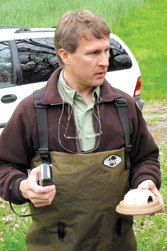The Chucky madtom is so rare, a mere 15 of the little catfish have been found in the last 70 years. And an attempt to breed two Chuckies caught in 2004 yielded no results, says U.S. Fish & Wildlife Service biologist Mark Cantrell.

“It looked like they were trying, because we caught them together, but they did not spawn,” the Asheville-based Cantrell reports.
The Chucky madtom is found only in Little Chucky Creek, a Greene County, Tenn., tributary of the Nolichucky River. A 1940 report claimed the diminutive fish had also been found in a stream in nearby Sevier County, but Cantrell has doubts about it, noting, “It’s a different site and a different habitat.” Like several other madtom species, the Chucky prefers warm-water, slow-moving streams with rocky or gravelly beds. Nocturnal and elusive, the fish “comes by its name honestly,” says Cantrell. When caught, the madtom thrashes about and swims erratically. “If you catch one, it’s quite a surprise to get stung by their barbs,” he reveals.
But the real challenge for biologists is how to study the Chucky, which may join three other rare, Southern Appalachian madtoms already on the federal endangered-species list (the smoky, yellowfin and pygmy varieties).
That’s where the made-in-Arden flowerpots come in. To study the Carolina madtom in the Tar and Neuse river basins in eastern North Carolina, scientists came up with the idea of gluing together two flowerpot saucers to create a kind of piscine honeymoon suite, Cantrell explains. In laboratory tests, the Carolina madtoms seemed to prefer the artificial shelter to mussel shells, rocks and leaves as a place to get up close and personal. For the Chuckies, a pair of flowerpot saucers glued together, with some pebbles and access holes thrown in, seemed to fit the bill.
Biologists recently peppered the bottom of Little Chucky Creek with 70 such shelters—equivalent to setting out bluebird boxes or bat houses as invitations to roost. “The Chucky madtom is incredibly rare, so we need to be innovative in our efforts to monitor this secretive fish,” says Cantrell. “This approach is a little unusual, but if successful, it could provide important nesting habitat.”
Finding the right saucers, however, proved a challenge: After combing eight different home-and-garden stores and coming up empty, Fish & Wildlife agents turned to Brown’s Pottery and Clay Company Co. in Arden. Brown’s, which opened in Virginia in 1740 and has been in the Asheville area since 1924, makes about 400 ceramic products, from flowerpots to apple bakers, and is known for its traditional face jugs, according to co-owner Charlie Brown, an eighth-generation potter. “This was a first” for the company, he says, “and we were glad to help out.”
Cantrell will be checking the madtom suites every few weeks, hoping for better results than a 2005 study in which scientists searched 12 sites on Little Chucky Creek and 22 on its tributaries without finding a single Chucky madtom. Turns out the bottom-feeders are highly susceptible to a simple type of stream pollution: “Sediment from poorly constructed roads, home construction and other sources accumulates in the gravel and smothers their food source,” he says. “Madtoms and other benthic fish are down there where it all falls out.”
In 2005, the Middle Nolichucky Watershed Alliance began working with property owners, other nonprofits and government agencies to provide better habitat, repairing eroded stream banks and making other improvements along Little Chucky Creek. The next step is helping the fish population recover. After all, both the smoky and yellowfin madtoms have already benefited from a reintroduction project in the Great Smoky Mountains National Park and Cherokee National Forest.
Cantrell hopes to accomplish something similar, explaining, “By putting out these devices, we hope to invite the Chucky madtom to come in.”



Before you comment
The comments section is here to provide a platform for civil dialogue on the issues we face together as a local community. Xpress is committed to offering this platform for all voices, but when the tone of the discussion gets nasty or strays off topic, we believe many people choose not to participate. Xpress editors are determined to moderate comments to ensure a constructive interchange is maintained. All comments judged not to be in keeping with the spirit of civil discourse will be removed and repeat violators will be banned. See here for our terms of service. Thank you for being part of this effort to promote respectful discussion.